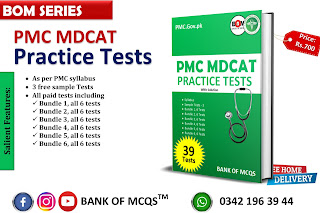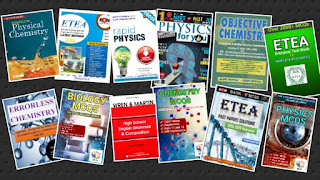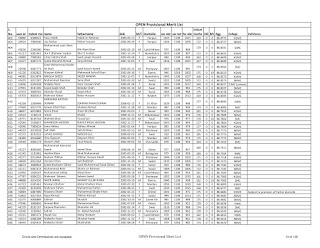chap.8 wave MCQs with solution
|
1)
|
. Waves transmit ________ from one place to another. b)
Energy b) Mass c) Both d) None |
A |
|
|
2)
|
The
waves that require a material medium for their propagation are called b)
Matter waves b)
Electromagnetic waves c) Carrier waves d)
Mechanical waves |
D |
|
|
3)
|
The
example of mechanical waves is: b)
Water and air waves b)
Radio waves c)
Infrared waves d)
Ultra violet waves |
A |
|
|
4)
|
Sound
waves cannot travel through: b)
Air b)
Water c) Material medium d) Vacuum |
D |
|
|
5)
|
Sound
waves do not travel in vacuum because a) They are transverse waves b) They are stationary waves c) They require material medium for propagation d) They do not have enough energy |
C |
|
|
6)
|
The
velocity of sound in vacuum is: a) 332 𝑚𝑠 −1 b) 333 𝑚𝑠
−1 c) 280 𝑚𝑠
−1 d) 0 𝑚𝑠 −1 |
D |
|
|
7)
|
The
speed of sound in air at 0°𝐶 is 332 𝑚𝑠 −1 . the speed at 2°𝐶 will be: a) 330 𝑚𝑠 −1 b) 333.2 𝑚𝑠 −1 c) 335 𝑚𝑠 −1 d) None of these |
B |
|
|
8)
|
According
to Laplace correction sound travel in
air under the conditions of a) Adiabatic b) Isothermal c) Isobaric d) Isochoric |
A |
|
|
9)
|
Laplace
expression for speed of sound in a
gase is: b) 𝑣 = c) 𝑣 = |
C |
|
|
10) |
If
the pressure of the gas is doubled, then
the speed
of sound: a) Also doubled b) Becomes half c) Not affected d) Increases four times |
C |
|
|
11) |
The
speed of sound in air at 30°𝐶 is approximately equal to: a) 332 𝑚𝑠 −1 b) 335 𝑚𝑠
−1 c) 340 𝑚𝑠
−1 d) 345 𝑚𝑠 −1 e) 350 𝑚𝑠
−1 |
E |
|
|
12) |
Increase
in velocity of sound in air for 1°𝐶 rise in temperature is: a) 0.61 𝑚𝑠
−1 b) 61 𝑚𝑠 −1 c) 1.61
𝑚𝑠 −1 d) 2 𝑚𝑠 −1 |
A |
|
|
13) |
The
speed of sound is greater in solids
than in gases due to high value of: a) Density b) Pressure c) Elasticity d) Temperature |
C |
|
|
14) |
The
distance between any two consecutive
crests or troughs is called a) Frequency b) Period c) Wave length d) Phase
difference |
C |
|
|
15) |
When
two identical waves moves in the
same direction, they give rise to: a) Standing waves b) Interference c) Beats d) None of
these |
B |
|
|
16) |
When
path difference is an integral
multiple of wavelengths, the effect is called: a) Coherency b) Destructive interference c) Constructive interference d) Phase lag |
C |
|
|
17) |
Periodic
alteration of sound between maximum
and minimum loudness are called a) Interferece b) Resonance c) Doppler effect d) Beats |
D |
|
|
18) |
Beats
can be heard when the difference of
frequency is not more than: a) 8 b) 4 c) 10 d) 6 |
C |
|
|
19) |
Beats
are formed when two notes of
frequencies 𝑓1 and 𝑓2 (𝑓1 > 𝑓2 ) are sounded together. The beat frequency
will be: a) 𝑓1 + 𝑓2 b) 𝑓1 − 𝑓2 c)
|
B |
|
|
20) |
The
number of beats produced per second
is equal to a) The sum of the frequencies of two tuning forks b) The difference of the frequencies
of two tuning forks c) The ratio of the frequencies of
two tuning forks d) The frequency of either of the
two tuning forks |
B |
|
|
21) |
When
a wave is reflected on going from a
rarer to a denser medium, then at the boundary the reflected wave will
undergo a phase change of: a) 0o b) 90o c) -90o d) 180o |
D |
|
|
22) |
When
a transverse wave is reflected on
going from a denser to a rarer medium, then at the boundary the reflected
wave undergoes a phase change of: a) 0° b) 90° c) −90° d) 180° |
A |
|
|
23) |
When
a transverse wave is reflected on
going from a denser medium to a rare
medium, then: a) There is 180° phase shift b) There is no change in phase c) A crest is converted into trough d) A trough is converted into crest |
B |
|
|
24) |
Phase
differce of 180° is equivalent to a path
difference of: a) 𝜆 b)
λ/2 c)
λ/4 d)
λ/8 |
B |
|
|
25) |
Two
waves of equal frequency travelling in opposite direction produce: a) Interference b) Stationary waves c) Beats d) Doppler Effect |
B |
|
|
26) |
Two
wave trains of the same amplitude
and frequency travelling in opposite
directions along the same path in the same medium produce: a.
Resonance b.Beats c.Standing
waves d.
Musical notes |
C |
|
|
27) |
Which
property of wave motion distinguish
a travelling wave from a stationary
wave: a) amplitude b) frequency of vibration c) propogation of energy d) direction of vibration |
C |
|
|
28) |
If
a string vibrates in n loops, the
wavelength of stationary waves will be b)
2l/n b)
nl/2 c) 2n/l d)
l/2n |
A |
|
|
29) |
Stationary
waves are generated on a string of length “l”, its fundamental frequency
is given by: a) 𝑓1 = 𝑣 × 𝑙 b) 𝑓1 = 2v/𝑙 c) 𝑓1 = 2 𝑣 × 𝑙 d) 𝑓1 = 2l/𝑣 |
B |
|
|
30) |
The
fixed ends of a vibrating string are a) antinodes b) nodes c) overtones d) neither nodes nor anti-nodes |
B |
|
|
31) |
At
the open end of an organ pipe: a) Nodes are formed b) Antinodes are formed c) Either nodes or antinodes may form d) Neither nodes nor antinodes may |
B |
|








Comments
Post a Comment